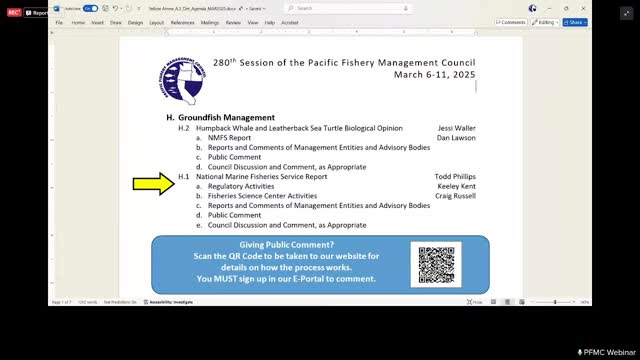Northwest Fisheries Science Center outlines 2025 survey and assessment schedule, flags budget and staffing uncertainty
March 08, 2025 | Fishery Management Council, Pacific, Governor's Office - Boards & Commissions, Executive, Washington
This article was created by AI summarizing key points discussed. AI makes mistakes, so for full details and context, please refer to the video of the full meeting. Please report any errors so we can fix them. Report an error »

The Northwest Fisheries Science Center (NWFSC) briefed the council on stock assessment progress, upcoming survey plans and constraints on staff and funding that could affect delivery of assessments and surveys.
Survey and assessment schedule highlights
- Benchmark and update assessments: NWFSC identified upcoming data deadlines and pre‑assessment workshops for benchmark species (yellowtail rockfish, quillback, chilipepper, rough‑eyed and shortraker types, and sablefish) and update assessments with March and April data deadlines; the first STAR panel for benchmark assessments is scheduled for May in Seattle.
- 2025 groundfish bottom trawl survey: Two passes are planned using several fishing vessels (Excalibur, Last Straw, Miss Julie, Noah's Ark) to maintain the coastwide bottom‑trawl time series.
- 2025 Southern California rockfish hook‑and‑line survey: Planned for Sept. 24–Oct. 10 using three industry vessels (Mirage, Aggressor, Tornado) to collect hook‑and‑line independent data.
- Integrated West Coast Pelagic Survey (hake + coastal pelagics): For 2025 the NWFSC and Southwest Fisheries Science Center plan a combined survey from the U.S.–Mexico border to Dixon Entrance, Alaska (June 11–Sept. 14) using NOAA Ship Shimada and Canadian Ship Franklin. The new multifunction trawl system was tested in gear trials; the survey will conduct acoustics, midwater and surface trawling and collect environmental and eDNA samples. NWFSC reported 3 years of eDNA time series are already available and that eDNA was used as a sensitivity index in the hake assessment for the first time.
Budget, staffing and risks
NWFSC noted that, at the time of the briefing, no final federal budget had been enacted. The center is constrained by a regulatory/administrative freeze that limits travel, hiring and contracting. Those constraints — together with planned retirements or workforce changes — could delay survey execution, samples processing and delivery of stock assessments in September. The center said it will provide more detail on impacts if funding or staffing shortfalls materialize.
Context and council next steps
Council members thanked the center for the schedule and encouraged continued communication. The center offered to provide an informational update at the April council meeting on assessment progress and timing so the council can incorporate realistic expectations into workload planning.
Ending
NWFSC emphasized that the integrated pelagic survey will increase ecosystem data collection (acoustics, eDNA, midwater/surface trawls) and maintain critical survey time series, but warned that delivery and sampling timelines depend on final budget and staffing decisions.
Survey and assessment schedule highlights
- Benchmark and update assessments: NWFSC identified upcoming data deadlines and pre‑assessment workshops for benchmark species (yellowtail rockfish, quillback, chilipepper, rough‑eyed and shortraker types, and sablefish) and update assessments with March and April data deadlines; the first STAR panel for benchmark assessments is scheduled for May in Seattle.
- 2025 groundfish bottom trawl survey: Two passes are planned using several fishing vessels (Excalibur, Last Straw, Miss Julie, Noah's Ark) to maintain the coastwide bottom‑trawl time series.
- 2025 Southern California rockfish hook‑and‑line survey: Planned for Sept. 24–Oct. 10 using three industry vessels (Mirage, Aggressor, Tornado) to collect hook‑and‑line independent data.
- Integrated West Coast Pelagic Survey (hake + coastal pelagics): For 2025 the NWFSC and Southwest Fisheries Science Center plan a combined survey from the U.S.–Mexico border to Dixon Entrance, Alaska (June 11–Sept. 14) using NOAA Ship Shimada and Canadian Ship Franklin. The new multifunction trawl system was tested in gear trials; the survey will conduct acoustics, midwater and surface trawling and collect environmental and eDNA samples. NWFSC reported 3 years of eDNA time series are already available and that eDNA was used as a sensitivity index in the hake assessment for the first time.
Budget, staffing and risks
NWFSC noted that, at the time of the briefing, no final federal budget had been enacted. The center is constrained by a regulatory/administrative freeze that limits travel, hiring and contracting. Those constraints — together with planned retirements or workforce changes — could delay survey execution, samples processing and delivery of stock assessments in September. The center said it will provide more detail on impacts if funding or staffing shortfalls materialize.
Context and council next steps
Council members thanked the center for the schedule and encouraged continued communication. The center offered to provide an informational update at the April council meeting on assessment progress and timing so the council can incorporate realistic expectations into workload planning.
Ending
NWFSC emphasized that the integrated pelagic survey will increase ecosystem data collection (acoustics, eDNA, midwater/surface trawls) and maintain critical survey time series, but warned that delivery and sampling timelines depend on final budget and staffing decisions.
View full meeting
This article is based on a recent meeting—watch the full video and explore the complete transcript for deeper insights into the discussion.
View full meeting
